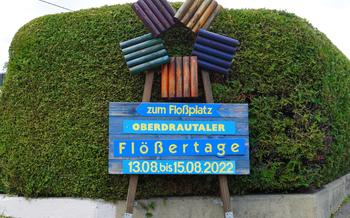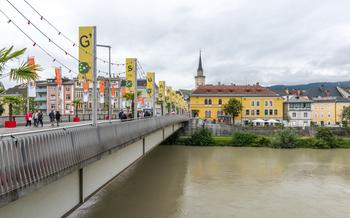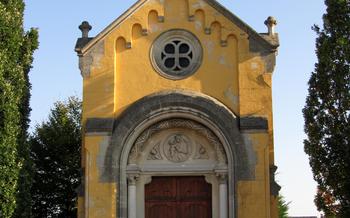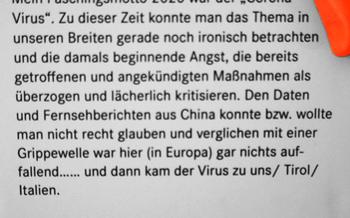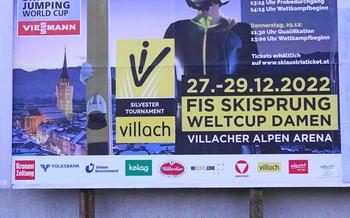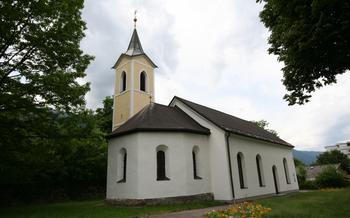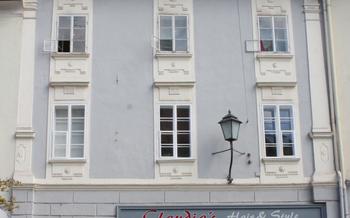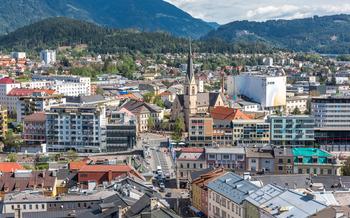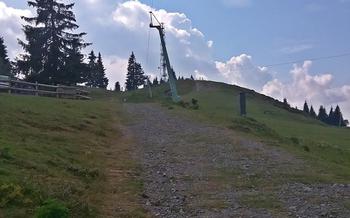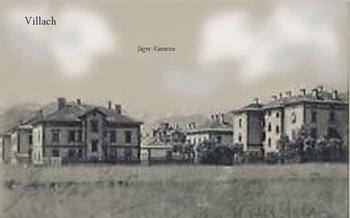
Museum der Stadt Villach – Widmanngasse
- Villach’s Historical Museum
- Exhibits and Displays
- Carinthian History
- Villach's Urban Development
- Temporary Exhibitions
- Guided Tours
- Museum Shop
- Accessibility and Visitor Facilities
- Educational Programs
- Visiting Hours
- Ticket Prices and Admissions
- Getting There
- Surrounding Area
- Insider Tip
Villach’s Historical Museum
The Museum der Stadt Villach – Widmanngasse is a treasure trove of historical artifacts and exhibits that provide a fascinating glimpse into the rich cultural heritage of Villach and the surrounding Carinthian region. Founded in 1873 by local historian and archivist Anton Kreuzer, the museum was initially housed in the city hall before finding its permanent home in the Widmanngasse in 193The Widmanngasse, a picturesque street lined with historic buildings, is named after the noble Widmann family, who played a prominent role in Villach's history. The museum's location in this charming setting adds to its allure and makes it a must-visit destination for anyone interested in exploring Villach's past.
Exhibits and Displays
The Museum der Stadt Villach boasts a diverse collection of exhibits and displays that showcase the rich history and culture of Villach and the surrounding Carinthia region. The exhibits are organized chronologically, taking visitors on a journey through time from the earliest settlements in the area to the present day.
Among the highlights of the museum's collection are artifacts from the Roman era, including coins, pottery, and tools. Visitors can also learn about the city's medieval history through exhibits on the city's fortifications, its role as a trading center, and the devastating fires that destroyed much of the city in the 13th and 14th centuries.
The museum also houses a significant collection of art and crafts from the Renaissance and Baroque periods, including paintings, sculptures, and furniture. There are also exhibits on the city's industrial heritage, its role in the two World Wars, and its transformation into a modern tourist destination.
The Museum der Stadt Villach is a treasure trove of information and artifacts that provide visitors with a deep understanding of the city's history and culture. Whether you are interested in Roman ruins, medieval architecture, Renaissance art, or modern history, you are sure to find something to fascinate you at this museum.
Carinthian History
The Museum der Stadt Villach not only delves into the urban development of Villach but also serves as a captivating showcase for the rich history and culture of Carinthia, the southernmost state of Austria. Through its diverse exhibits and displays, visitors are invited on a journey through time, exploring the region's distinct identity and heritage.
The museum highlights key historical events that have shaped Carinthia, from its Celtic and Roman roots to its incorporation into the Holy Roman Empire. Visitors can gain insights into the region's medieval period, marked by the rise of powerful dynasties and the construction of magnificent castles and monasteries. The Habsburg era, which spanned several centuries, left an indelible mark on Carinthia, and the museum sheds light on the region's role within the vast Habsburg Empire.
Beyond historical narratives, the museum also explores Carinthian culture and traditions, showcasing the region's unique customs, festivals, and صنایع دستی. Interactive exhibits and activities bring Carinthian history to life, allowing visitors to immerse themselves in the region's vibrant heritage. Whether it's learning about traditional costumes, tasting local delicacies, or participating in hands-on workshops, the museum offers a truly engaging and interactive experience for visitors of all ages.
Villach's Urban Development
The Museum der Stadt Villach also delves into the urban development of Villach, showcasing the city's transformation from a small Roman settlement to a bustling modern metropolis. Visitors can explore exhibits that highlight the city's architectural heritage, including its medieval fortifications, Renaissance palaces, and Art Nouveau buildings. Models and maps illustrate the city's growth and development over the centuries, providing insights into the challenges and opportunities that Villach has faced. The museum also examines the city's role as a center of trade and commerce, as well as its rich cultural and social history. Visitors can learn about the people, events, and institutions that have shaped Villach's unique identity over the centuries.
Temporary Exhibitions
In addition to its permanent collection, the Museum der Stadt Villach regularly hosts temporary exhibitions that explore various aspects of Villach's history, culture, and art. These exhibitions showcase a diverse range of topics, from contemporary art installations to historical artifacts and documents. The temporary exhibitions are often curated in collaboration with local artists, historians, and cultural institutions, ensuring a fresh and engaging perspective on Villach's rich heritage.
Visitors to the museum can expect to see a variety of temporary exhibitions throughout the year, each offering a unique opportunity to delve deeper into the city's past and present. Some of the recent temporary exhibitions have focused on topics such as the history of Villach's Jewish community, the development of the city's urban landscape, and the works of local artists.
The temporary exhibitions are typically displayed for several months and are included in the museum's regular admission fee. Visitors can find information about upcoming temporary exhibitions on the museum's website or by inquiring at the museum's information desk.
Guided Tours
Enrich Your Museum Experience with Guided Tours
To enhance your visit to the Museum der Stadt Villach, guided tours are available to provide a more in-depth and engaging experience. Led by knowledgeable and passionate guides, these tours offer a deeper understanding of the exhibits and the historical significance of Villach.
Languages and Costs
Guided tours are offered in German, the native language of Villach, and English, catering to international visitors. The tours typically last for about an hour and come with a modest fee. It's advisable to check the museum's website or inquire at the information desk for the exact cost and availability of guided tours.
Booking and Advance Arrangements
To ensure a spot on a guided tour, especially during peak tourist season, it's recommended to book in advance. You can make reservations online through the museum's website or by calling the museum directly. Walk-in visitors can also inquire about tour availability on the day of their visit, but subject to availability.
Unveiling Villach's Stories
With a guided tour, you'll gain insights into the rich history of Villach, from its humble beginnings to its transformation into a vibrant cultural hub. The guides will share captivating stories and anecdotes, bringing the exhibits to life and shedding light on the characters and events that shaped the city's identity.
Immerse Yourself in Villach's Past
Whether you're a history buff, a curious traveler, or simply seeking a deeper connection with Villach, a guided tour of the Museum der Stadt Villach is an enriching experience that will leave you with a lasting appreciation for this charming city.
Museum Shop
The Museum der Stadt Villach boasts a well-stocked gift shop where visitors can purchase a variety of souvenirs and mementos of their visit. From postcards and magnets to books and prints, the museum shop offers a wide selection of items to suit every taste and budget.
One of the highlights of the museum shop is the collection of unique and exclusive items that cannot be found anywhere else. These items include hand-crafted jewelry, ceramics, and glassware, all inspired by the museum's collection and the history of Villach.
The museum shop is open during the same hours as the museum, making it easy for visitors to browse and purchase items before or after their visit. Whether you are looking for a small gift for a loved one or a special keepsake for yourself, the Museum der Stadt Villach gift shop is sure to have something for everyone.
Accessibility and Visitor Facilities
The Museum der Stadt Villach is committed to providing a welcoming and accessible environment for all visitors. The museum is wheelchair accessible, with ramps and elevators throughout the building. There are also accessible restrooms and designated parking spaces for visitors with disabilities.
For visitors who are deaf or hard of hearing, the museum offers assistive listening devices and closed captioning for videos. Visitors who are blind or visually impaired can request a sighted guide or a braille guidebook. The museum also offers tactile exhibits and audio descriptions of exhibits for visitors who are blind or visually impaired.
The museum has a number of visitor facilities to make your visit more enjoyable. There are lockers and storage facilities for visitors' belongings, as well as a coat check. There is also a café and a restaurant in the museum, where visitors can purchase food and drinks.
Educational Programs
Enriching Young Minds: Interactive Learning at the Museum der Stadt Villach
The Museum der Stadt Villach recognizes the importance of education and offers a range of engaging programs and workshops tailored to children and school groups. Designed to spark curiosity and foster a love for learning, these programs bring history and culture to life through interactive activities, hands-on experiences, and storytelling.
Exploring Carinthia's Past: Interactive Workshops for School Groups
School groups can embark on a journey through time as they delve into the rich history of Carinthia. Through interactive workshops and guided tours, students will uncover the region's fascinating past, from ancient settlements to modern-day developments. They will learn about the diverse cultures, traditions, and challenges that have shaped Carinthia over the centuries.
Creative Expression and Artistic Endeavors: Art Workshops for Children
For children, the museum offers art workshops that encourage creativity and self-expression. Young artists can unleash their imaginations as they explore different mediums and techniques, creating their own unique artworks inspired by the museum's collection. These workshops provide a platform for children to develop their artistic skills, learn about different cultures, and express their own unique perspectives.
Fees and Booking Information: Ensuring Accessibility for All
Educational programs and workshops are offered at a nominal fee, ensuring that they are accessible to all schools and groups. To book a program or workshop, simply contact the museum's education department in advance. The museum staff is dedicated to accommodating the needs of each group, tailoring programs to specific age levels and interests, and ensuring a memorable and enriching experience for all participants.
Visiting Hours
The Museum der Stadt Villach is open to the public from Tuesday to Sunday, with varying hours depending on the season. During the summer months (April to October), the museum is open from 10am to 5pm, while during the winter months (November to March), it is open from 10am to 4pm. The museum is closed on Mondays and public holidays. Visitors are advised to check the museum's website for any special hours or closures before planning their visit. To avoid crowds and enjoy a more leisurely experience, it is recommended to visit the museum during the off-peak hours, which are typically in the morning or late afternoon.
Ticket Prices and Admissions
Admission to the Museum der Stadt Villach is affordable, making it accessible to visitors of all budgets. A standard ticket for adults costs around 5 euros, while children and students can enjoy discounted rates. Family tickets are also available, offering a great value for families with children.
To enhance the visitor experience, the museum offers guided tours for an additional fee. These tours provide a deeper insight into the museum's exhibits and the history of Villach and Carinthia. Guided tours can be booked in advance or on the day of the visit, subject to availability.
For those interested in exploring multiple attractions in Villach, the museum offers combination tickets that include admission to other museums, historical sites, and cultural institutions. These tickets provide a cost-effective way to experience the city's rich cultural heritage.
Getting There
Museum der Stadt Villach – Widmanngasse is situated in the heart of Villach's old town, a stone's throw away from the main square, Hauptplatz. Reaching the museum is a breeze, thanks to its central location.
For those arriving by public transport, the museum is easily accessible by bus or train. The nearest bus stop, Widmanngasse, is served by several bus lines, while the Villach Hauptbahnhof, the city's main railway station, is just a short walk away.
For those who prefer to drive, there is a paid parking garage, Parkhaus Widmanngasse, located just a few steps from the museum. Please note that parking fees apply and may vary depending on the duration of your stay.
The museum is situated in a safe and walkable neighborhood, making it easy to explore the surrounding area on foot. Take advantage of this opportunity to soak in the charm of Villach's old town and discover its numerous attractions, such as the Stadtpfarrkirche St. Jakob, the Rathaus, and the Villacher Stadtpark.
Surrounding Area
The Museum der Stadt Villach is situated in the heart of the city, within easy walking distance of many other attractions and landmarks. The Villach Hauptplatz, the city's main square, is just a few steps away, where visitors can admire the picturesque Town Hall and the Holy Trinity Column.
The Drau River, which flows through Villach, offers beautiful riverside walks and cycling paths. Visitors can also take a boat trip on the river to explore the surrounding countryside. The Villacher Alpenarena, a popular sports and recreation complex, is located just a short drive from the museum.
In terms of dining options, there are numerous restaurants, cafes, and bars in the vicinity of the museum. Visitors can choose from a variety of cuisines, including traditional Austrian fare, Italian dishes, and international specialties.
The museum is located in a safe and walkable neighborhood, making it easy for visitors to explore the city on foot. There are also several other museums and cultural institutions nearby, such as the Carinthian Museum of Modern Art and the Villach City Museum.
Insider Tip
Uncover the Hidden Gems of Villach's History
Explore the Museum's Courtyard: Step into the serene courtyard of the Museum der Stadt Villach, where you'll discover a hidden oasis adorned with ancient artifacts and sculptures. Take a moment to soak in the tranquil ambiance and admire the intricate details of these historical treasures.
Join a Thematic Tour: Enhance your museum experience by participating in one of the themed tours offered periodically. These tours delve deeper into specific aspects of Villach's history, providing unique insights and perspectives that bring the past to life.
Attend Special Events: Keep an eye out for special events and exhibitions hosted by the museum throughout the year. These events often showcase rare artifacts, host guest speakers, or feature interactive activities that offer a fresh take on Villach's rich history.
Engage with Local Historians: Don't hesitate to engage with the museum's knowledgeable staff or local historians who are always eager to share their passion for Villach's history. Ask questions, seek recommendations, and gain a deeper understanding of the city's fascinating past.
Respect Local Customs: As you explore the museum and the surrounding area, be mindful of local customs and etiquette. Show respect for the city's heritage and traditions by asking permission before taking photographs of sensitive subjects or engaging in conversations with locals.
